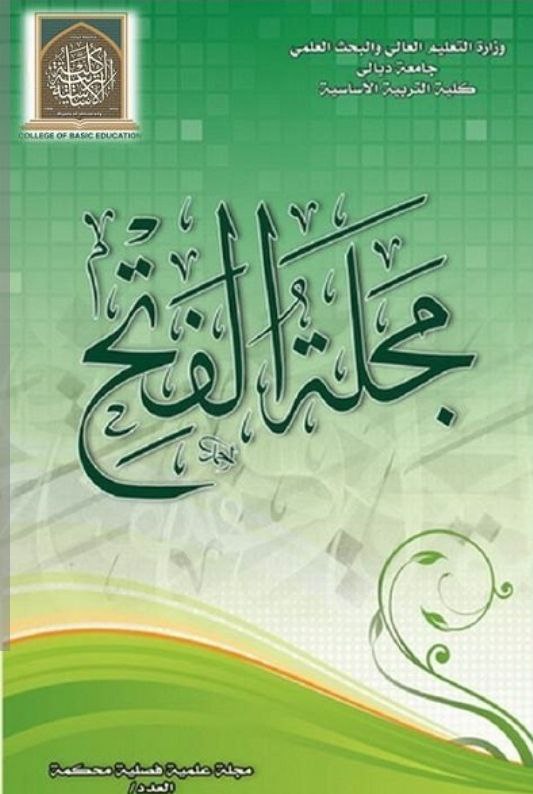The Correlation between Law College Students' Self-Efficacy and their Writing Achievement in English Language
Abstract
There is no doubt that writing is one of the most difficult
skills for second language learners to master, in particular,
for law college students who learn English for legal
purposes. Acquiring writing skills that are highly complex is
not the only factor which makes students achieve success in
writing. There are other factors which influence students'
outcome achievement like having confidence in their own
capabilities known as self-efficacy beliefs. The construct of
self-efficacy has received increasing attention and has been
proved to have a significant positive correlation with writing
achievement. Consequently, students who have high selfefficacy in their own writing skills, are expected to
accomplish writing tasks successfully, on the other hand,
those who show low self-efficacy are expected to fail even
before they start writing.
The aims of this study are:
1.Investigating the correlation between law college students
self-efficacy and their writing achievement in English
language.
2.Identifying the difference in gender between male and
female law students as for self-efficacy and achievement.
3.Identifying Law students' performance in the self-efficacy
scale.
References
Bachman, L. & Palmer, A. (1996).Language Testing in
Practice: Designing and Developing Useful Language
Tests. Oxford: Oxford University Press.
Balci,A. (2013). A Study on Correlation Between SelfEfficacy Perceptions and Writing Skills of Students with
Turkish Ancestry and Foreign Students. Mustafa Kemal
University, Faculty of Education.
Bandura, A. (1994). Self-Efficacy, Encyclopedia of
Human Behavior ( vol. 4 pp.71-81). New York Academic
Press.
Broaddus,M. B. (2012).Students' Writing Self-Efficacy,
Motivation, and Experience: Predictors in Journalism.
Ph.D. Diss. University of Tennessee, Knoxville.
http://trace. Tennessee.edu/Utk-graddiss/1275
Brown,w. (1987). Principles of Language Learning and
Teaching. New Jersey: Prentice Hall.
Corder, S. (1993). Introducing Applied Linguistics.
London: Penguin Books.
Codruta, B. E.(2012). Teaching Legal English as a Second
Language. Christian University "Dimitrie Catemir".
Harmer, J. (2007). How to Teach English. Essex: Pearson
Education Limited.
Mills, S. (2010). Self-Efficacy for Writing. George Mason
University. Psych. 557.
Pajares, F. & Schunk, D. (2001). Self Beliefs and School
Success: Self-Concepts, and School Achievements.
London: Alex Publishing. (pp. 239-266).
Pajares, F. ; Hartely, J. & Valiante, G. (2001). Response
Format in Writing Self-Efficacy Assessment: Greater
Discrimination Increases Prediction. Measurement &
Evaluation in Counseling & Development, vol. 33, Issue
Al-Fath Journal …………………………………..…………..No.64.December 2015
/http.www.alfatehmag.uodiyala.edu.iq
-17-
Pajares, F. (2002). Self-Efficacy Beliefs in Academic
Context: An Outline. Emory University. http:// des.
Emory.edu/ mfp/effta/htm.
Pajares, F. (2003). Self-Efficacy Beliefs, Motivation and
Achievement in Writing : A Review of the Literature.
Georgia: Taylor & Francis.
Richards, J. & Renandya, W. (2002). Methodology in
Language Teaching. Cambridge: Cambridge University
Press.
Richards, J. & Schmidt, R. (2002). Longman Dictionary of
Language Teaching and Applied Linguistics. London:
Longman.
Schmidt, K. & Alexander, J. (2012). The Empirical
Development of an Instrument to Measure Writerly SelfEfficacy in Writing Centers. The Journal of Writing
Assessment, vol.5, Issue 1.
Shunk, D.(1985). Self-Efficacy and Classroom Learning.
Psychology in the Schools. Blackwell
http:// www3.interscience. wiley.com
Downloads
Published
How to Cite
Issue
Section
License
Copyright (c) 2023 مجلة الفتح للبحوث النفسية والتربوية

This work is licensed under a Creative Commons Attribution 4.0 International License.
حقوق النشر والترخيص
تطبق مجلة الفتح للبحوث التربوية والنفسية ترخيص CC BY (ترخيص Creative Commons Attribution 4.0 International). يسمح هذا الترخيص للمؤلفين بالاحتفاظ بملكية حقوق الطبع والنشر لأوراقهم. لكن هذا الترخيص يسمح لأي مستخدم بتنزيل المقالة وطباعتها واستخراجها وإعادة استخدامها وأرشفتها وتوزيعها ، طالما تم منح الائتمان المناسب للمؤلفين ومصدر العمل. يضمن الترخيص أن المقالة ستكون متاحة على نطاق واسع بقدر الإمكان وأن المقالة يمكن تضمينها في أي أرشيف علمي.
لمزيد من المعلومات، يرجى متابعة الرابط: https://creativecommons.org/licenses/by/4.0/.



